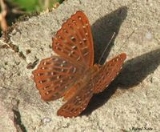
Zemeros flegyas
Encyclopedia

Butterfly
A butterfly is a mainly day-flying insect of the order Lepidoptera, which includes the butterflies and moths. Like other holometabolous insects, the butterfly's life cycle consists of four parts: egg, larva, pupa and adult. Most species are diurnal. Butterflies have large, often brightly coloured...
found in South Asia
South Asia
South Asia, also known as Southern Asia, is the southern region of the Asian continent, which comprises the sub-Himalayan countries and, for some authorities , also includes the adjoining countries to the west and the east...
and Southeast Asia
Southeast Asia
Southeast Asia, South-East Asia, South East Asia or Southeastern Asia is a subregion of Asia, consisting of the countries that are geographically south of China, east of India, west of New Guinea and north of Australia. The region lies on the intersection of geological plates, with heavy seismic...
that belongs to the Riodinidae
Riodinidae
The Riodinidae are a family of butterflies. The common name "metalmarks" refers to the small metallic-looking spots commonly found on their wings. There are approximately 1,000 species of metalmark butterflies in the world...
family.
Description
- See glossaryGlossary of Lepidopteran termsThis glossary describes the terms used in the formal descriptions of insect species, jargon used mostly by professionals or entomologist....
for terms used
Like many tropical butterflies they show different wet and dry season forms.
Wet-season form
Male upperside is vinaceous brown, the veins ochraceous brown. Fore and hind wings crossed by four series of minute white spots, the postdiscal series very often obscure, each spot bordered inwardly by a more or less elongate black spot; a terminal very slender black line; cilia alternately black and white. Underside is bright ochraceous brown, the veins conspicuously paler, the white black-bordered spots as on the upperside but larger, more clearly defined and prominent. Antennae brown ringed with white; club black, ochraceous at apex; head, thorax and abdomen concolorous with the wings ; beneath, the palpi, thorax and abdomen slightly paler than the wings.Dry-season form
_at_samsing,_duars,_west_bengal_w_img_5946.jpg)
Underside is similar to the underside in the wet-season form, but the groundcolour a shade darker; the veins not conspicuously paler; the white spots as in the wet-season form, except the postdiscal and subterminal series on the fore wing, which are as on the upperside, the anterior large white spots of the postdiscal series being very prominent; the inner black bordering to the white spots much smaller than in the wet-season form. Antennae, head, thorax and abdomen as in the wet-season form.
Females have the upper and undersides similar to those of the wet-season form, but the ground-colour brighter and paler; markings also similar, but the black bordering to the white spots less prominent.
Larva
Pupa
Other references
- Evans, W.H. (1932) The Identification of Indian Butterflies. (2nd Ed), Bombay Natural History Society, Mumbai, India
- Wynter-Blyth, M.A. (1957) Butterflies of the Indian Region, Bombay Natural History Society, Mumbai, India.

